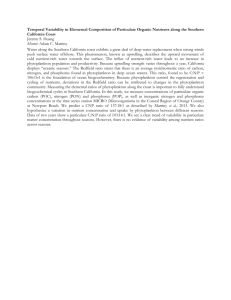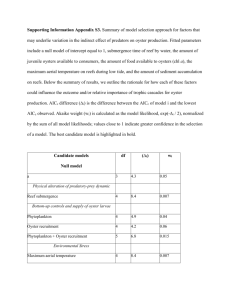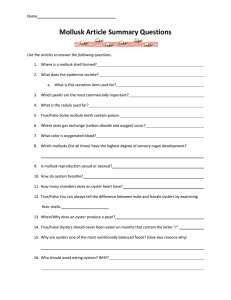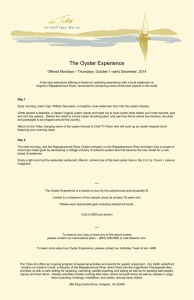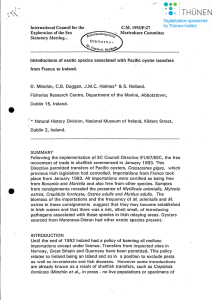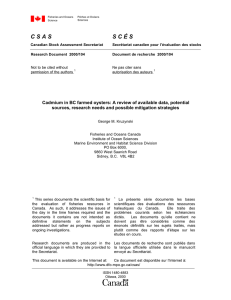Kristin J. Orians University of British Columbia In collaboration with:
advertisement
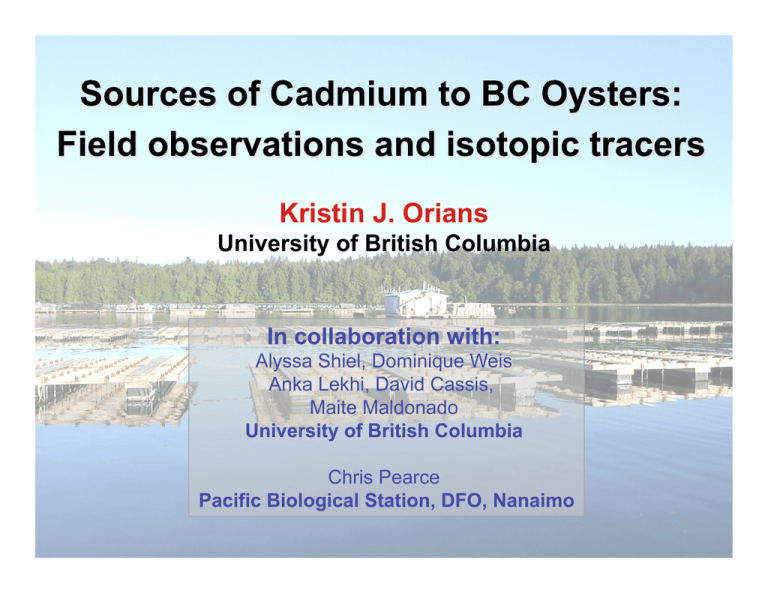
Kristin J. Orians University of British Columbia In collaboration with: Alyssa Shiel, Dominique Weis Anka Lekhi, David Cassis, Maite Maldonado University of British Columbia Chris Pearce Pacific Biological Station, DFO, Nanaimo • Dissolved vs. Particulate • Natural – Upwelling – Local mineralogy • Anthropogenic – – – – – – Mine drainage Incinerators Metal smelters Phosphate fertilizers Sewage treatment plants Pulp mills Logging near Effingham Inlet, Barkley Sound (Kruzynski, 2004) • Oysters and mussels from B.C., Mexico, California, and Washington (1) • Oysters of Oman (2) • Scallops of the Ross Sea, Antarctica (3) • Mussels of the Kuril Islands (Russia) (4) Diss. Cd (nmol/kg) Temp (oC) High Cd! Merrin & Orians Upwelling locations Three distinct upwelling locations, each with low T and high Cd! (Cd from 0.2 to 0.5 nmol/kg) upwelling Cadmium elevated during upwelling events (Cd: 0.7 to 1.0 nmol/kg) Mussel Cd followed (Amphitrite Point - West coast Vancouver Island) (Lares and Orians, 1997) Dissolved Cd Particulate Cd Oyster But… • Annual / seasonal cycles • Effect of environment (Sal., Temp., etc.) • Not all particulate matter is the same! Sampling sites Deep Bay Lemmen’s Inlet Priyanka Lekhi, D. Cassis, C.M. Pearce, N. Ebell, M.T. Maldonado, K.J. Orians, 2008. Role of dissolved and particulate cadmium in the accumulation of cadmium in cultured oysters (Crassostrea gigas). Science of the Total Environment, 393, 309-325. • Annual cycle: Oyster Cd high in winter, low in summer • Dissolved Cd: main source for oysters in Deep Bay • Particulate Cd: a sink, not a source • Growth: dilutes oyster Cd concentrations in summer • Environment: temperature, salinity, etc. - strong seasonal effect • Phytoplankton/particulate Cd: a sink, not a source of Cd for oysters! • Phytoplankton lowers dissolved Cd (makes Cd less available to the oysters) • Phytoplankton abundance AND composition important (some species are not oyster food) • Many phytoplankton not eaten by oysters (harmful, big, spiny algae) • Phytoplankton and Cd removed by sedimentation Harmful algal bloom (HAB) Phytoplankton Dissolved Cd Oyster Arrow width: 2 x natural logarithm of p-value of correlations Sedimentation rates from GarciaHernandez et al, 2005 Sediment Spring Summer Fall Winter Phytoplankton Diatom blooms, high sedimentation HA Blooms, very high sedimentation Diatom blooms, low sedimentation Very low Dissolved Cd and nutrients High: winter renewal Low: strong phytoplankton uptake and removal Medium High Oyster Cd High: winter Low: growth and reduced exposure Starts increasing due to exposure High Strong water mixing begins Strong water mixing Decreasing Decreasing Increasing Decreasing Oceanography Strong water mixing Thermo/halo stratification • Models under development: use variables easy to measure in field (temp., salinity, oyster age, dissolved nutrients) to predict oyster Cd. • Need validation with other datasets! (only for Deep Bay now) • Potentially very useful for oyster growers! Seasons Phytoplankton HAB Growth Reproduction Oceanographic processes Sediment Dissolved Cd West side of Vancouver Is. Isotopes: same atomic number (same chemistry) different mass (different reaction rates) (‰) Also reported as δCd/amu, e.g. δ114Cd/amu = δ114Cd / (114-110) Cd isotope variations relative to High Purity Cd standard (similar to most terrestrial rocks - the “natural” signature) “Light” = more negative = less 114Cd Desolation Sound Barkley Sound North Brittany Gironde estuary Light Heavy Gulf of Lion, Mediterranean Cd isotopes “lighter” in some oysters than others. Why? Note: Total oyster Cd (concentration) is not correlated with Cd isotopes! • Biological Fractionation? - by oysters? - from their food? • Anthropogenic Sources? • How do values compare to local seawater? Phytoplankton preferentially take up “light” Cd! Oysters may also fractionate Cd? Oysters may assimilate light Cd from phytoplankton? Edmonton Calgary Vancouver Teck Trail operations light heavy heavy End product Source material Effluent Fumes light Cd isotopes fractionated during smelting and refining Cd isotopes in BC oysters: a bit lighter than North Pacific seawater. ? Smelter emissions could contribute to lighter isotopes in oysters. Pollution source? light heavy light heavy



